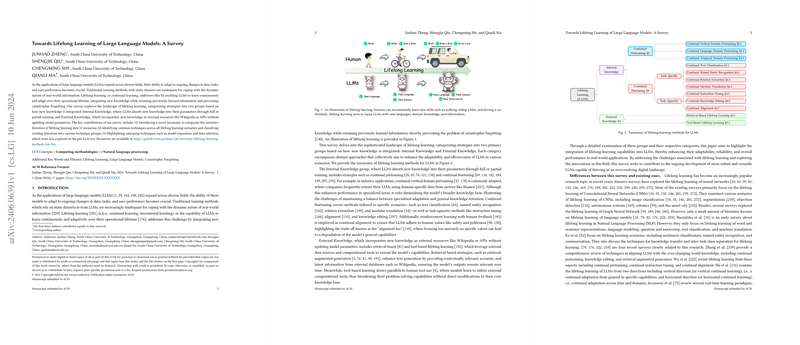Towards Lifelong Learning of LLMs: A Survey
The paper "Towards Lifelong Learning of LLMs: A Survey" provides a detailed examination of current methodologies and techniques in the domain of continual learning (CL) for LLMs. This survey encapsulates the advances made in various sub-domains such as text classification, named entity recognition (NER), relation extraction, machine translation, instruction tuning, knowledge editing, and alignment.
Overview
Lifelong learning, also referred to as continual learning, addresses the challenge of enabling LLMs to incrementally acquire, adapt, and transfer knowledge without forgetting previously learned information. The paper discusses several resilience mechanisms against catastrophic forgetting, including replay methods, regularization techniques, distillation, architectural modifications, and parameter-efficient fine-tuning (PEFT).
Methodological Highlights
A multitude of strategies are highlighted for different NLP tasks:
- Continual Text Classification and NER:
- The survey extensively compares various state-of-the-art methods along dimensions such as replay mechanisms, regularization, and architecture. Techniques like replay and distillation are prevalent, with models like CL-KD and IDBR employing distillation strategies to retain prior knowledge.
- Named entity recognition (NER) models like KCN and ExtendNER similarly leverage replay and distillation to mitigate forgetting, with emphasis on maintaining a balance between learning new entities and preserving the recognition of old ones.
- Continual Relation Extraction:
- The methods reviewed are heavily inclined towards replay-based techniques and knowledge distillation. Notably, models like CML and EMAR employ meta-learning and prototype-based strategies to adapt to new relationships while stabilizing previously acquired ones.
- Continual Machine Translation:
- Techniques in this domain vary from vocabulary-based strategies as seen in Berard et al.'s work to regularization and pseudo-replay methods employed by COKD and EVS.
- The integration of decomposed vector quantization and vocabulary substitution is specifically noted to enhance the ability of LLMs to generalize to new languages and dialects without significant degradation of performance on previously learned languages.
- Instruction Tuning and Knowledge Editing:
- Continual instruction tuning methodologies are emphasized for their ability to manage diverse dialogue systems and instruction-following models. Techniques like pseudo-sampling in LAMOL and parameter-efficient adapters in BiHNet demonstrate significant promise.
- In knowledge editing, approaches like GRACE and TPatcher utilize novel architectural adjustments like GRACE Adapters and transformer patching to incrementally update and correct factual knowledge within LLMs.
- Continual Alignment:
- The paper delineates strategies for aligning LLMs to dynamic objectives such as ethical guidelines and fairness metrics, exemplified by Zhao et. al.'s approach integrating LoRA for alignment through self-correction strategies.
Notable Findings
The survey reveals that:
- Replay Techniques: Models consistently harness replay mechanisms to reuse past data, thus preventing forgetting.
- Regularization and Distillation: Regularization methods (e.g., L2 regularization) and distillation help in maintaining the stability-plasticity balance.
- Parameter-Efficient Fine-Tuning: Methods like LoRA, Adapters, and Delta tuning present efficient ways to adapt large models incrementally without extensive resource costs.
Implications and Future Directions
The implications of this research span both practical applications and theoretical advancements:
- Practical Impact: The ability to maintain and build upon historical knowledge in dynamic environments such as customer service chatbots, adaptive educational tools, and continual aspects of large-scale translation systems.
- Theoretical Advancements: The continuous refinement of architectures and PEFT techniques pushes the frontier of how LLMs can evolve with minimal performance regressions on previously mastered tasks.
Future research will likely explore optimizing computational efficiency and refining the synergy between various lifelong learning strategies. There's potential for exploring cross-disciplinary applications and further standardizing evaluation metrics for continual learning in LLMs.
In sum, this survey provides a comprehensive analysis of state-of-the-art techniques and paves the way for future innovations in the continual learning paradigm for LLMs.
